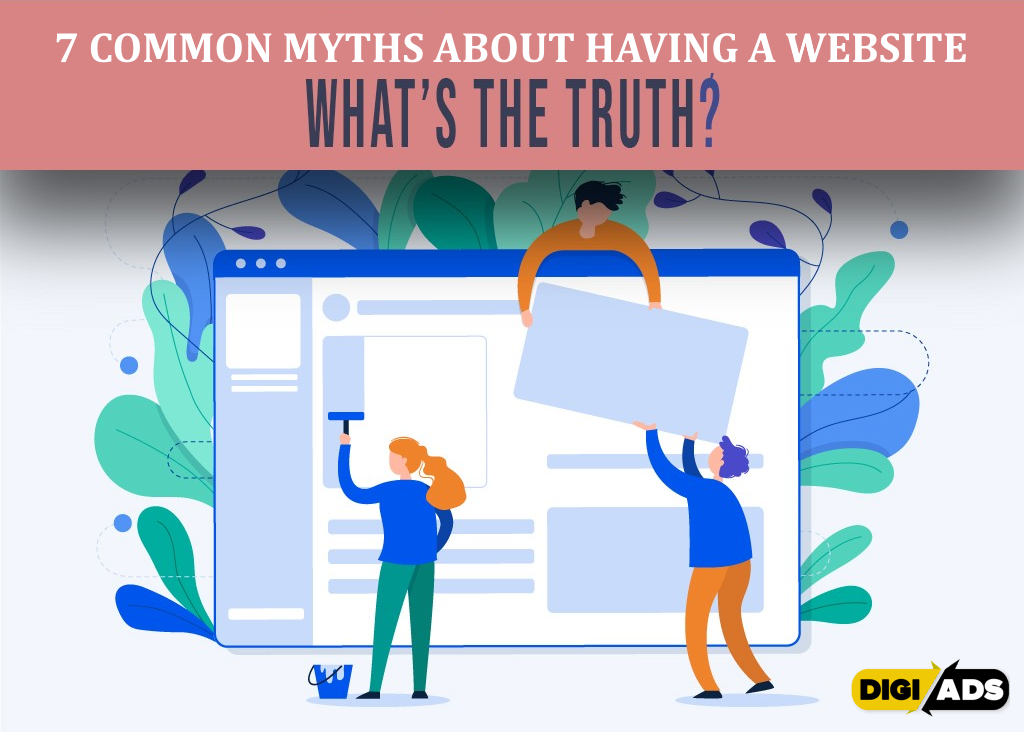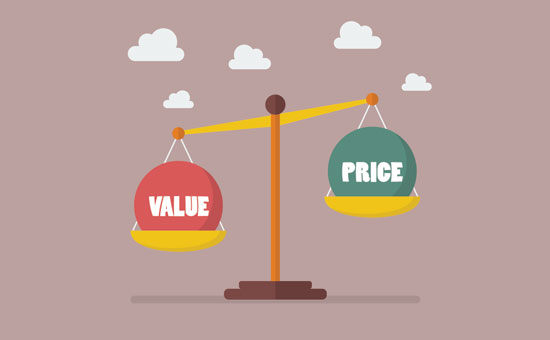A good website can make a good first impression, but it can also leave a lasting effect. Regardless of whether you’re thinking about redesigning your existing website or looking into having a website designed for the first time, there is no denying the impact a well-designed website can make. There are a plethora of myths around having a website.
You probably already know not to believe everything you read on the internet, and the same can be said about the internet itself, not everything you hear about how websites should be built is correct.
With the rapid growth of technological ability, there’s a lot a misconception about what it takes to create and market a website. In an effort to clear up those misconceptions, and the resulting mistrust of web developers, this post breaks down the 7 common website myths surrounding website ownership, so you can learn to make your website work for you.
Table of Contents
Myth 1. Every business needs a website.
Are you absolutely sure you need a website?
Many people think that having a website is only for eCommerce business owners who are selling products or services online. Often, these people are business owners themselves but of the brick-and-mortar variety. They don’t see the value in having a website and are happy to generate leads through word of mouth like they always have.
If you look at any small town, the vast majority of the plumbing and construction companies will have no web presence at all, and that’s because of this myth.
Your business may make a ton of sales through direct customers — and a website may add little or nothing to that. For some businesses, a Facebook page or shop is enough of a presence.
Many businesses create a website because they think they should have one — and often spend thousands of naira. They never recoup that money because the website doesn’t actually bring them more customers.
What’s the Truth?
Focus on the need. Get clear on the ‘who?’, ‘what?’ and ‘why?’.
Whether you own a retail store, a house painting company, or a medical clinic, people are searching for you online. They use apps like Google Maps to search for businesses around them and learn more about those businesses. While some small business owners may be able to get away with not having a website, if their competitors are on the web, not having a website will, at some point, start to hurt sales.
All types of businesses need a website and not just to attract new people. Having one helps build a relationship with customers, too. The more information you provide for your visitors, the more trust you’ll earn, and that’s critical when you’re trying to grow your business.
Myth 2. A great website can be done on the cheap.
In this day and age, it’s easy to find website templates that allow you to get a site up and running quickly and at a low price. Although it may be tempting to save the extra money, there are many reasons why you should invest in a custom website.
The first thing I’d suggest doing is to look at how much your billable hour is, then decide how long you think it will take you to learn several web design concepts… then do the math. Likely you’ve already realized you can save money by hiring an agency! You are awesome at what you do… and likely that is not web design.
A website is rarely an add-on. It’s most likely the centre of your marketing world. It needs resources and a realistic budget. Your website is like a house project with you as the site manager. Unless you’re skilled in copywriting, research, design, branding, online marketing and SEO then you’ll need a team. In most cases, investing in solid foundations and professional help will earn you money in the long run. It will also save you time.
What’s the Truth?
The best way to ensure that you have a website that looks good, works great, and is user friendly is to work with a web design agency/specialist who understands the importance of creating a site that properly reflects your brand identity. This allows the agency to help you build a website that is marketing-focused and that will communicate the right message to the right audience. Simply put, a website that converts is going to make you money…and website that doesn’t loses you money.
Customizing a template to represent you will inevitably limit your possibilities, but by investing a little more money into a custom site, you have the freedom to create something that uniquely encompasses who you are, what you’re about, and what your customers need.
Myth 3. Once I Have a Website, I’ll Immediately Get Leads or Traffic.
If only this was true!
You just launched a new website with a cool design, but don’t expect to see thousands of new customers coming in the very next day! A new design doesn’t automatically grow your traffic or fix your conversion rate. It’s one thing to launch a well-designed website, it’s another thing to bring in greater traffic and conversions.
Too many people create their website and assume people will stumble across it, because why wouldn’t they? It’s so beautiful. But the web is a big haystack, and your needle just one among millions. How is anyone going to find it? Building a website won’t automatically revolutionize your business – unless you actually promote it!
What’s the Truth?
Thinking website? Think website promotion plan first.
It takes time, skill, and resources to build your audience with a consistent SEO strategy, paid ads, constant monitoring, and updates, and adding new content to help your website show up in the search engine results.
Once you get started, you’ll find out which strategies work best for your website. The bottom line is, you have to take action; when you do, you’ll begin seeing an increase in traffic.
Myth 4: Design Once and You’re Done
One of the longest living myths in the online word is that once you’ve published your website it’s done. This idea couldn’t be further from the truth.
When you build a website, that’s only the beginning. While most people understand the need to nurture and maintain other aspects of their business, they sometimes fail to grasp the fact that their website needs ongoing attention too.
What’s the Truth?
You’ll need to maintain your website. That includes renewing your domain registration on time, protecting your website from viruses and cybercrime, updating its design to keep up with current trends, and investing in promotion, so people visit it.
Here are some of the best ways to prevent your website from becoming the most out-of-date site on the internet:
- Start a blog or news section and consistently add valuable content that your site visitors can read and enjoy.
- Test website functionality like links, web forms, and navigation menus, making sure it easily works not only on a computer but on phones and tablets as well. This is especially important if you’re noticing that there are pages that are getting a lot of traffic visiting but the links, forms or menus aren’t being utilized.
- A/B test. Things like web forms, landing pages, CTA buttons, layouts, color schemes, and fonts can be routinely tested to see which yields better results.
- On evergreen content, change up outdated images and ensure content is still relevant. This gives people something fresh and new to look at.
- Monitor the speed and performance of your site to prevent abandonment.
Optimize your site for better search rankings (e.g., keywords, image compression, and content readability). All of these things, and so much more, need to be done regularly, even long after your site first goes live.
Myth 5: Responsive Design Is Nice, But not Necessary
The world as we know it is saturated with devices, all ranging in size from smartphones to desktops, and all accessing the Internet differently. Like it or not, mobile traffic is surpassing desktop traffic so by not having a responsive website, you’re automatically alienating millions of potential customers.
But what if you’ve looked at your analytics and you can see that the vast majority of your visitors are on desktop? Surely then you don’t need to worry, right? Wrong!
Thinking that because your site looks great on your computer, it will look good on all computers and devices is a myth that needs debunking right now.
What’s the Truth?
In order to have a successful site, you need to be able to incorporate good web design into multiple devices.
Google has moved to a ‘mobile-first indexing’ method. That means that they crawl the mobile versions of websites rather than the desktop ones, because no matter what the stats for your individual site, it doesn’t change the fact that the majority of web traffic globally is through mobile devices.
As far as Google are concerned, a site needs to be responsive to be effective. Therefore, that’s what they’re looking for, no matter what. Which means it doesn’t matter where your traffic is coming from, you still need a mobile-friendly design.
Responsive design is not a nice-to-have, it’s a must-have. Responsive design benefits your SEO while making it possible for users to easily access your site and your content regardless of the size of their screen.
Myth 6: The homepage is the most important element
A homepage is one of the most important parts of any website. But some people are under the mistaken impression it’s the only thing that’s important when it comes to web design.
The homepage is like the entryway of a house; it welcomes people as the walk in, but it’s not where people sit and stay awhile. You want to make sure that your home page does a good job of welcoming your visitors and introducing yourself, but don’t forget that sub-pages are where you’ll make them feel at home.
The homepage is one of the most visited and most important pages of a website, no question. But homepage views are decreasing, and you’ll find that plenty of other pages are contributing far more value.
What’s the Truth?
Some people will never see your website’s homepage unless they actively click on it while exploring other areas of your site. They may have landed on a blog post from search results, a product page from a paid ad or affiliate link, or even a landing page from a social media post.
Whatever the case may be, your site visitors are likely to land on many different pages depending on their individual circumstances. As a result, you should focus your design efforts equally throughout your website so that no matter where people land, the design and user experience are consistent.
Myth 7: The More Features, the Better
It’s a misconception that having more features on your website will make it better. New features come out and of course we as humans want to include them to show we’re modern and keeping up and know latest trends.
Sometimes, people add features to their website without considering their value. They end up offering a whole array of things to their audience that aren’t really needed. More features mean more choices, and that just makes it tougher for consumers to make a decision.
What’s the Truth?
We recommend that you keep your website simple. Your audience doesn’t care about bells and whistles. What they care about is the value they get from your products or services. Too many features on your website will detract from the site’s main purpose, so it’s best to leave out any features that don’t add value for your visitors.
In fact, the more features you implement, the more variables there are. More elements that need to be integrated, more time to load the page, more tweaks and customisation to the code.
From typography and colors to images and your logo, every element communicates something to the visitor. If your company’s website is too busy or distracting, it’s likely that visitors won’t have a positive experience, nor is it likely they’ll stick around and convert to a lead. Focus on a simple design that enhances the features, attracts visitors and limits distractions.
Myths: Busted! What’s Next?
There’s no denying the role good website design plays in helping you to find digital success, but it doesn’t stop there. An attractive, responsive, quick loading site is key, but good website design is wasted if no one knows your site exists. That’s where good SEO steps in and takes that well designed website and turns it into a top ranking site.
We’ve heard a lot opinions when it comes to digital marketing, and web development and design. You’ll hear people say a lot about what it means to have a website.
Myths are not always widely held false beliefs or ideas. In fact, many web design “myths” were once deemed best practices by even the most experienced web designers. But things change, ideas evolve, and site visitors demand different things from the websites they visit.
Are there any myths on our list that you believed to be true?
If you need help with your website’s overall design and want to ensure it’s accessible as well, get in touch with us today. We can help you develop a plan for your website that ensures a seamless user experience, incorporates the best web design practices, and is accessible so everyone can enjoy what you have to offer.







